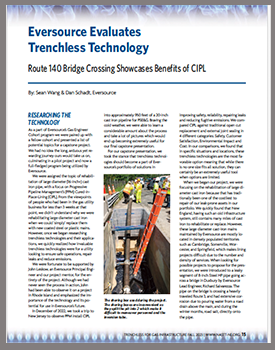INDUSTRY
APPLICATION
CLIENT
WORLD RECORD CIPL
highlights
42” CAST IRON GAS MAIN REHABILITATION
LENGTH: MULTIPLE SEGMENTS
LOCATION: EAST ORANGE, NEW JERSEY
DATE: JULY 2019
background & situation
The 42-inch diameter cast iron gas line along Central Ave. in East Orange, NJ travels 80 feet directly down an embankment and then crosses under the road and back up 25 feet to the other side of the street. The segment of pipe had leaks around the joints. Gas distribution company Public Service Electric & Gas (PSE&G) contracted Progressive PIpeline Management (PPM) to renew the section using Starline® Cured-in-Place-Lining (CIPL). In this dense, high traffic area, there was no viable alternative other than trenchless rehabilitation to renew the gas main. Replacing this section of pipe conventionally would have cost tens of millions of dollars and created massive disruption.
PPM is the only company with the expertise and extensive testing protocol required to deliver the Starline® CIPL lining technology to the gas industry. The patented technology utilizes a liner that is bonded to the host pipe with a special epoxy. Independent testing of cured in place lining of pipe in live pressurized gas service determined an additional 100+ years of life.
Scope
Each lining job required two excavations or access pits on each side of the pipe segment to be lined. These were dug into Central Ave. about 600 feet apart. During the project, the street remained open. Once PSE&G completed the excavations and shutdown the gas main, PPM began the CIPL renewal process with a pre-cleaning CCTV camera inspection. This was done to determine the internal pipe surface conditions, geometry of seven offset bends and locate any anomalies or areas of concern.
Next, the surface of the pipe was cleaned with a unique combination of abrasive blasting and vacuum removal process. The actual lining process required about 2.5 weeks for inspecting, cleaning, lining, curing and pressure testing the pipe before returning the gas main to service.
Challenges
The section of pipe to be lined had multiple grade changes, seven offsets and material changes from cast iron to steel. Because of the large diameter of the pipe and the multiple bends, the cleaning process presented new challenges.
The method for cleaning smaller diameter pipe would not be effective. The team identified a self-propelled robotic sandblasting head with an electric motor for internal cleaning of pipelines 36 inches and up. After internal testing of the new robotic head, PSE&G approved to use it for cleaning the 42 inch main. An attached video camera enabled real-time viewing of the cleaning results inside the pipe as it progressed. It worked brilliantly, saving time and improving the cleaning process.
Every bit of grit used for cleaning had to be extracted from the pipe to enable the liner to adhere to the host pipe. The pipeline had an unusual configuration; it traveled down and back up a steep embankment. Testing and reconfiguration of the vacuum equipment was performed to optimize velocities impacting flow rates and minimize difficulties with grit extraction. Moving to dust collection units with 64,000 CFM air flow was the silver bullet in complete grit recovery. This was significant considering the pipe diameter and geometry. The next CCTV inspection showed that it was clean without any obstructions.
OUTCOMES & RESULTS
A special inversion drum was designed and fabricated, due to the lessons learned for a previous world record for a 36” diameter gas pipeline renewal. These modifications significantly reduced equipment set-up time, and increased capacity and crew efficiency. The liner was inverted through a total of seven bends and a drip pot with a 48” gap that was bridged with an internally installed forged steel structural reinforcement sleeve. While the planning and design of the project was very challenging, the execution was smooth. The day of the inversion had a forecast of extreme heat and lining was started at 4 am due to concerns about the effect of the heat on resin pot life. The lining process was completed ahead of schedule. The main was back online ahead of the deadline. Post lining CCTV inspection confirmed the liner was tightly bonded with the host pipe, smooth and free of anomalies. The 42” underground, high pressure natural gas main rehabilitated in July 2019 was a world record for the largest diameter pipeline to be lined in the world. The achievement was possible only with first ever technical advancements and innovations that continue to refine and improve CIPL’s efficacy for the nation's local distribution companies (LDCs.)
About PPM: Progressive Pipeline Management is a full service contractor and team of highly skilled infrastructure renewal specialists. For over twenty one years, PPM has been improving the safety and longevity of pipeline infrastructure. PPM holds the exclusive licensee in North America for the Starline® Cured-in-place-lining. The team has specialized expertise including gas pipeline rehabilitation, restoration of damaged or leaking infrastructure, PIPES ACT compliance and trenchless technology, facilities pipe renewal and site services.
RELATED PROJECT PROFILES
REPAIRING BRIDGE PIPELINE WITH CIPL AVOIDS COSTLY REPLACEMENT
Cured-in-place-line (CIPL) eliminated leaks from a gas pipeline without disturbing the bridge.
CLIENT
PSE&G
LOCATION
EAST ORANGE, NJ
YEAR
2020
CIPL TURNKEY SOLUTION FOR LEAK PRONE PIPE
Comprehensive turnkey approach proved to be effective for remediating leak-prone-pipe.
CLIENT
NATIONAL GRID
LOCATION
QUEENS, NY
YEAR
2021
PIPELINE WALL CONDITION ASSESSMENT TOOL
Broadband Electromagnetic (BEM) probe measured wall thickness of gas pipeline prior to a CIPL project.
CLIENT
PSE&G
LOCATION
WEST DEPTFORD, NJ
YEAR
2022
EMERGENCY NATURAL GAS PIPELINE REPAIR
Cured-in-place -liner (CIPL) eliminated leaks from a critical, difficult to access gas main.
CLIENT
PSE&G
LOCATION
SOUTH ORANGE, NJ
YEAR
2020












